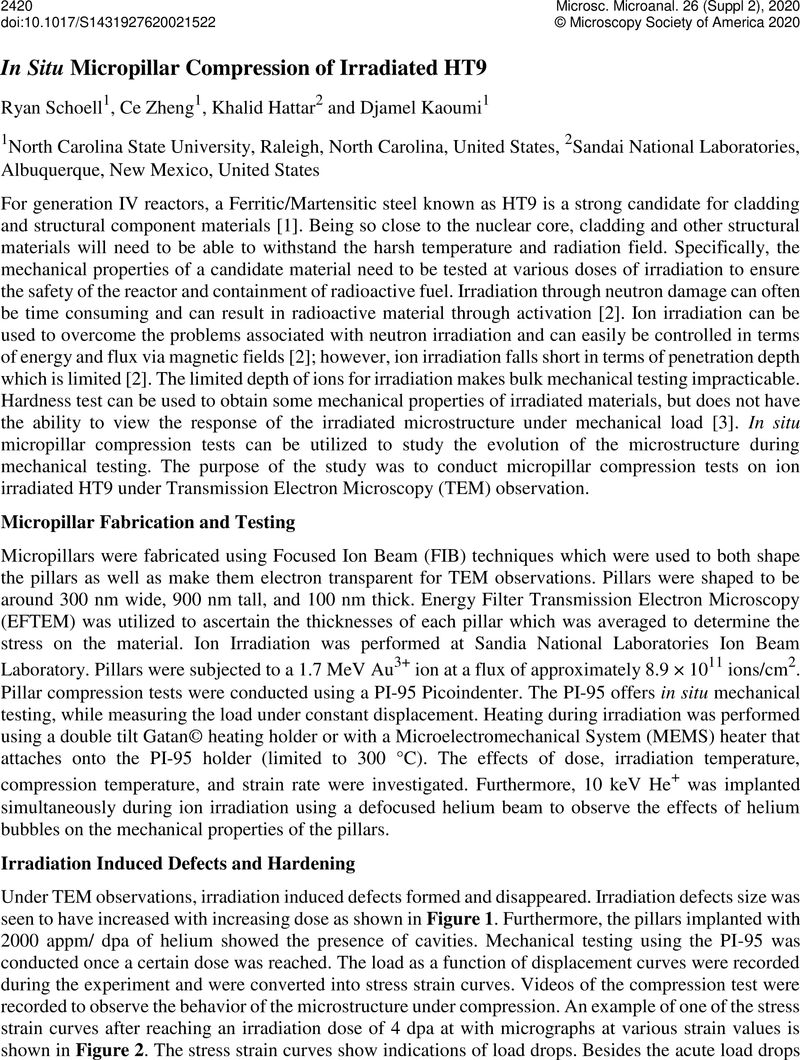No CrossRef data available.
Article contents
In Situ Micropillar Compression of Irradiated HT9
Published online by Cambridge University Press: 30 July 2020
Abstract
An abstract is not available for this content so a preview has been provided. As you have access to this content, a full PDF is available via the ‘Save PDF’ action button.

- Type
- In Situ TEM at the Extremes
- Information
- Copyright
- Copyright © Microscopy Society of America 2020
References
Klueh, R.L. and Nelson, A.T., Ferritic/martensitic steels for next-generation reactors. Journal of Nuclear Materials, 2007. 371(1): p. 37-52.10.1016/j.jnucmat.2007.05.005CrossRefGoogle Scholar
Ribis, J., et al. ., Comparison of the neutron and ion irradiation response of nano-oxides in oxide dispersion strengthened materials. Journal of Materials Research, 2015. 30(14): p. 2210-2221.10.1557/jmr.2015.183CrossRefGoogle Scholar
Heintze, C., et al. ., Irradiation hardening of Fe–9Cr-based alloys and ODS Eurofer: Effect of helium implantation and iron-ion irradiation at 300 °C including sequence effects. Journal of Nuclear Materials, 2016. 470: p. 258-267.10.1016/j.jnucmat.2015.12.041CrossRefGoogle Scholar
Gao, J., Yabuuchi, K., and Kimura, A., Ion-irradiation hardening and microstructural evolution in F82H and ferritic alloys. Journal of Nuclear Materials, 2019. 515: p. 294-302.10.1016/j.jnucmat.2018.12.047CrossRefGoogle Scholar
Heintze, C., et al. ., Ion irradiation combined with nanoindentation as a screening test procedure for irradiation hardening. Journal of Nuclear Materials, 2016. 472: p. 196-205.10.1016/j.jnucmat.2015.07.023CrossRefGoogle Scholar
This work was supported by the U.S. Department of Energy, Office of Nuclear Energy under DOE Idaho Operations Office Contract DE-AC07- 051D14517 as part of a Nuclear Science User Facilities experiment. This work was performed, in part, at the Center for Integrated Nanotechnologies, an Office of Science User Facility operated for the U.S. Department of Energy (DOE) Office of Science. Sandia National Laboratories is a multimission laboratory managed and operated by National Technology & Engineering Solutions of Sandia, LLC, a wholly owned subsidiary of Honeywell International, Inc., for the U.S. DOE's National Nuclear Security Administration under contract DE-NA-0003525. The views expressed in the article do not necessarily represent the views of the U.S. DOE or the United States Government.Google Scholar



